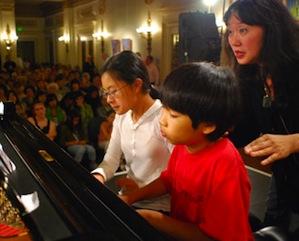M@M's World-Class Hothouse/Hotbed/Hotspot for Young Musicians
Music@Menlo will celebrate its 10th anniversary this summer with "Resonance," a major performing retrospective of the decade, but you will read about that here only in future editions. The subject here now is how a partially internal festival activity has become one of its major glories.
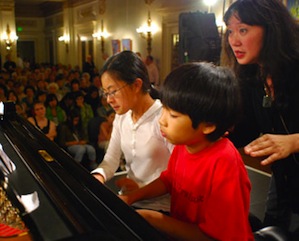
I will not talk about the festival schedule ranging from the July 21 opening concert, already sold out, but repeated the next day, (Schubert, Mozart, and Beethoven, with Anthony McGill, Juho Pohjonen, Benjamin Beilman, David Finckel, and the Pacifica Quarter) to the Aug. 11 closing concert (Mendelssohn, Paul Schoenfield, Moritz Moszkowski, Chausson, with Jose Franch-Ballester, Inon Barnatan, Gloria Chien, Wu Han, Ani Kavafian, Kristin Lee, Sean Lee, Arnaud Sussmann, and Dmitri Atapine).
Festival co-directors Wu Han and David Finckel have always been deeply involved with coaching, from years at Aspen to various festivals they have headed, but their work at Menlo is immense, and intense: You can see the two at every event, assisting and rooting for their charges.
Hundreds of young talent have gone through Menlo's programs — Gloria Chien's Chamber Music Institute and Gilbert Kalish's International Program — many of them to instant glory.
The Young Performers Program is open to ages 9 to 18 for a daily schedule of ensemble rehearsals, workshops, and coachings with the core teaching faculty, plus visiting artists. The selection process is exacting, tuition is pricey (although scholarships are available), but the program is virtually alone in its effectiveness.
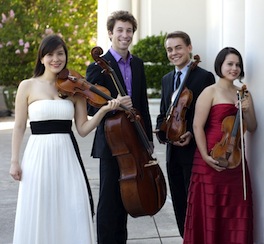
Take, for example, last month's Yehudi Menuhin International Violin Competition in Beijing, chronicled in this column at length. This is how five Music@Menlo students placed:
-
Kevin Zhu (2011), first prize winner, Junior Division
Kenneth Renshaw (2007-2008), first prize winner, Senior Division
Alexi Kenney (2003-2004, 2006-2008, 2010), third prize winner, Senior Division
Zenas Hsu (2005), semifinal round
Eunice Kim (2005-2006), semifinal round
The International Program, for pre- and semiprofessional artists, not only gathers and assists some of the stars of the near future, but its participants provide the Prelude Concerts, always a highlight of the festival.
Just a random update for recent International Program participants:
-
* The Amphion String Quartet appears this summer at Chamber Music Northwest, the OK Mozart Festival, and the La Jolla Music Society’s SummerFest
* Pianist Michael Brown won Juilliard's Petschek Recital Award, and made his solo recital debut in Alice Tully Hall last month
* Cellist Gabriel Cabezas won both first place and the Audience Choice Award in the Sphinx Competition in Ann Arbor, Mich.
* Cellist Eric Han was part of the "Curtis on Tour" in February, along with fellow Music@Menlo artists Jason Vieaux (guitar) and Roberto Díaz (viola)
* Pianist Maya Hartman had her Paris debut recital, and she will begin teaching at William Paterson University in New Jersey
* Cellist Michael Kaufman was a prizewinner in the 2012 Bach Competition, sponsored by the San Francisco early music group Voices of Music
* Violinist Hye-Jin Kim gave a recital at the Kravis Center in Palm Beach, Florida; will be a faculty member in the Young Performers Program this summer
And many, many more ... When you attend Music@Menlo this year, pay special attention to the young ones.
A Trombonist On Board SFCV
Chances are most people getting a new boss wouldn't be rude or reckless to ask her about eye-popping items in her resume, but then I am not known for excessive civility and, being a determined PC user, I am not an Apple-polisher.
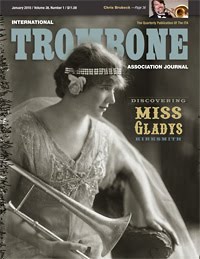
So now that Veronica Bashbush is scheduled to succeed John Robinson as SFCV executive director on June 18, I pondered her history as a trombone-playing aerospace engineer, and decided to delve into the former. Trombone players are a minority among instrumentalists, but women trombonists are rarer yet — or, at least, so it seems.
Perhaps the most prominent among them is Abbie Conant, former president of the International Trombone Association, and for a dozen years, solo trombonist of the Munich Philharmonic.
She is now leading a boycott of the upcoming International Trombone Festival in Paris because, she says, the organizers neglected to invite any women to participate as featured performers or composers — "There are 42 men invited as soloists and zero women. And all 7 composers are also men. Total: 49 to 0! This is insulting to all women trombonists, all women musicians, and all enlightened men."
The 2012 convention is not an exception. In 2009 (Arhus) and 2011 (Nashville) those zeros held true, and in 2010 (Austin), one woman trombonist was invited, in addition to 14 men.
Commenting on the situation, trombonist Jessica Ducharme said: "Have we as women grown numb to the fact that we have not been included or invited to this 'boys only' club? I think that may be the case. Well, we are not numb anymore, and unfortunately for M. Mauger [in charge of the Paris conference], we decided to bring awareness to this issue when he was organizing the festival."
None of the foregoing came from Bashbush, the issue popped up when I searched for women trombonists (of which Barbara Sigler is one locally, plus Amy Bowers with the Santa Rosa Symphony, and Santa Cruz Symphony principal trombone Katie Curran), Bashbush spoke only of her own experience:
I was introduced to the trombone at age 10 at our elementary school's "instrument day." Students had an opportunity to try out various string, woodwind, and brass instruments. I was immediately attracted to the trombone. It was rambunctious. It was loud. It was funny. It was fun.I asked about her Stanford years:The uniqueness of the slide stood out and I liked the idea of standing out. Ultimately, it was the great camaraderie I always felt as being part of the section — trombone players never take themselves too seriously, get a kick out of seeing who can hit the lowest/highest note, and always know how to play a prank or two on their fellow brass players.
When I picked up the trombone 22 years ago, I didn’t realize how truly life changing it would be. It is amazing how that one moment inspired me to change careers. Music is a tremendous gift that I received, and it is something that I am eager to share and explore with others.
My best memories about Stanford revolve around the band. It is refreshing to find a group of bright individuals who use music as the ultimate platform for self-expression and creativity. My favorite memory with the band was going to the Rose Bowl my freshman year, and "marching," or in our case, dancing, jumping, singing, and sharing our unique point-of-view with thousands of people.Musical memories?One of the things I continue to enjoy about the group is the attitude that music is an activity without barriers. It is not uncommon to look around and find an 18-year-old playing, talking, and joking alongside retired alumni. Today I continue to find as much time to play in big bands, orchestras, or small ensembles.
My most memorable concert was seeing Dudamel perform with the L.A. Philharmonic in Chicago, during Dudamel’s inaugural season. I never thought I’d get the chance, since his concerts were sold out in Chicago and in L.A. To my great surprise, I received a ticket to attend Dudamel’s concert as a going away gift from the Evanston Symphony, where I was completing my term as a Kellogg Board fellow.The ticket was also carefully chosen so that I could sit behind the trombones and watch Dudamel conduct. The gesture alone made it the most special concert I have attended. The opening was John Adams’ City Noir, followed by Tchaikovsky’s "Pathetique" Symphony.
Dudamel's passion was electrifying and it was incredible to experience that energy with everyone in the concert hall. That concert, just prior to graduating from Kellogg, also marked my professional entry into the field of music. A special day.
Diamond Anniversary (75) for Our Golden Gate
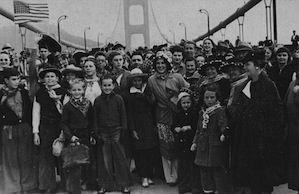
The gigantic fireworks on Sunday in San Francisco honored the bridge, which opened exactly three quarters of a century ago, on May 27, 1937, when:
The weather was typical for San Francisco in May: foggy, windy, and cold, but that didn't bother anyone. They would always remember they had walked across the Golden Gate Bridge on opening day.You were encouraged to wear a costume or the Official Hat with its tassels. But it was the Depression. If you couldn't afford the hat, a bandana would do just fine.
The Golden Gate Bridge Fiesta was a weeklong celebration that included a nightly pageant at Crissy Field, fireworks, parades, and entertainment.
The Fiesta began with Pedestrian Day — the entire roadway was opened exclusively to pedestrians from dawn to dusk. By 6 a.m., it is estimated that 18,000 people were waiting to cross. An estimated 15,000 an hour passed the turnstiles in a steady stream each paying 25 cents to cross. [Other accounts say it was free.] Scores of hot dog stands lined the roadway with estimates of up to 50,000 sold.
A number of "firsts" took place on May 27, with people competing to be the first to run, roller skate, tap dance, ride a unicycle, play a harmonica, push a baby carriage, and play a tuba, or cross on stilts. There is even the record of the first child lost (and found) — Anna Marie Anderson, 11.
Photo by Doug Atkins/AP
More nostalgia, of the operatic kind, and going all the way back in time, an 1854 street map of San Francisco, which could pretty much get you around town today.
Another Diamond Jubilee (60): the Queen and the Arts
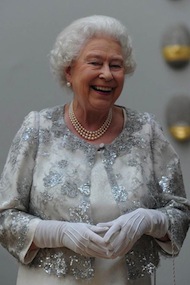 Part of Queen Elizabeth's Diamond Jubilee, on the 60th anniversary of her accession to the throne, was a huge arts reception last weekend at the Royal Academy. More than 800 turned out for the celebration, including Paul McCartney, David Hockney, Shirley Bassey, AS Byatt, Jacqueline Wilson, Antonia Fraser, and Kiri Te Kanawa.
Part of Queen Elizabeth's Diamond Jubilee, on the 60th anniversary of her accession to the throne, was a huge arts reception last weekend at the Royal Academy. More than 800 turned out for the celebration, including Paul McCartney, David Hockney, Shirley Bassey, AS Byatt, Jacqueline Wilson, Antonia Fraser, and Kiri Te Kanawa.
Hockney created a special drawing for the event program given to all guests, reports The Standard, and praised the Queen for hosting a party to celebrate Britain’s culture. He said: "The arts aren’t a luxury, they’re an essential. I don’t think we can quite rely on governments to see the bigger picture so we need the arts."
Bono came as a courtesy after the Queen’s "courageous and graceful" visit to Ireland last year. "I never do these things but I thought I really should," he said. "She charmed Ireland very hard and charmed me."Sir Derek Jacobi said it was a great occasion. "She has a reputation for not being that keen on theatre but to do something like this shows her heart really is in the right place."
In the official address, Theater Director Richard Eyre said the 60 years of the Queen’s reign had seen "an astonishing eruption of creative talent." Choir master Gareth Malone and concert promoter Harvey Goldsmith were given crystal chalices for their contribution to culture and five awards, funded by benefactors and the Queen, were given to support young artists.
Piano and Atheism Don't Mix in Turkey
Fazil Say, 42, an acclaimed Turkish pianist and former culture ambassador for the European Union, is facing indictment and prison time, if convicted, for alleged "violation of Islamic values."Say, who gave a concert yesterday in Tonhalle Zürich, may be sentenced to 18 months in prison for tweets in which endorsed atheism. Earlier this month Say was considering leaving the country for good, prompting Culture and Tourism Minister Ertugrul Günay to call on him to reconsider. Say replied to the minister on his Twitter account "to stop talking nonsense."
Günay said:
As the member of the government that is responsible for coordinating tourism and cultural affairs in the country, I am strictly careful not to say a word that will hurt an artist. But if some artists insist on saying negative things all the time, I leave it to society to evaluate. I hope that in the future these people will say there is no better place to live than Turkey.
Never Did More Get Less Than 125 Million Eurovision Viewers
 Watch a recap of Sunday's Eurovision Song Contest held Sunday in Baku, Azerbaijan, and explain what difference there is between one pulsing "simple song" and another.
Watch a recap of Sunday's Eurovision Song Contest held Sunday in Baku, Azerbaijan, and explain what difference there is between one pulsing "simple song" and another.
Honestly, even the second-place Buranovskiye Babushki of eight grandmothers from the Udmurt Republic sounded the same as all the bouncing young things from all over ... or as painfully out of place as 76-year-old Engelbert Humperdinck, representing the UK, and placing next to last.
Sweden's Loreen won the multi-million-dollar contest (for which the half-billion-dollar Crystal Hall was built), with a windblown Lady Gaga-wannabe "Euphoria," so the next Eurovision will take place in her country, on May 18, 2013. Mark your calendars now.
Glyndebourne Streaming
The London Guardian will stream six operas from the Glyndebourne Festival in Sussex this summer. See guardian.co.uk for Janáček's The Cunning Little Vixen, on June 10; Mozart's Le Nozze di Figaro, on Aug. 17, and the Ravel double-bill of L'Heure Espagnole and L'enfant et les sortilèges, on Aug. 19 live from the festival, which runs May 20 through Aug. 26.Two more operas in the season will be filmed and broadcast on the site: Rossini's La Cenerentola on June 22, and Purcell's The Fairy Queen, on July 22. Each opera will be made available to view again, and accompanied by additional multimedia commentary from Guardian critics, who will be online to discuss the operas as they are broadcast.
The Story of Film: an Odyssey
 San Francisco Film Society is screening the entire epic British TV series on the history of cinema, June 2 through July 21 at the SFFS Cinema, 1746 Post Street, a pair of hour-long episodes playing on eight consecutive Saturdays, beginning at noon.
San Francisco Film Society is screening the entire epic British TV series on the history of cinema, June 2 through July 21 at the SFFS Cinema, 1746 Post Street, a pair of hour-long episodes playing on eight consecutive Saturdays, beginning at noon.
Adapted from his book of the same name, Mark Cousins' exploration of film is designed to be a history of ideas and innovators rather than a charting of money and business, focusing on the development of cinematic language around the world. Comprehensive yet idiosyncratic, the series is packed with film clips and interviews with directors both beloved and underappreciated.
The schedule:
-
June 2: Part 1 "Birth of the Cinema" (1900-1920); "The Hollywood Dream" (1920s)
June 9: Part 2 "Expressionism, Impressionism and Surrealism: Golden Age of World Cinema" (1920s); "The Arrival of Sound" (1930s)
June 16: Part 3 "Postwar Cinema" (1940s); "Sex & Melodrama" (1950s)
June 23: Part 4 "European New Wave"; "New Directors, New Forms" (1960s)
June 30: Part 5 "American Cinema of the '70s"; "Movies to Change the World" (1970s)
July 7: Part 6 "The Arrival of Multiplexes and Asian Mainstream" (1970s); "Fight the Power: Protest in Film" (1980s)
July 14: Part 7 "New Boundaries: World Cinema in Africa, Asia, Latin America"; "New American Independents & the Digital Revolution" (1990s)
July 21: Part 8 "Cinema Today and the Future" (2000s)
Star Cellist Curses in Chinese, Apologizes in Russian
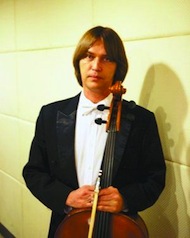
Perusing Shangaiist.com last week, I came across a symphonic tabloid story that should caution temperamental musicians to mind their manners or else.
Oleg Vedernikov, the principal cellist of the Beijing Symphony Orchestra and the most famous Russian expat in China, is now officially jobless. The orchestra has decided to sack him for his "uncivilized behavior" in an incident on a high-speed train headed from Shenyang to Beijing last week.
In a video taken by a fellow passenger and placed on the Internet, Vedernikov was seen placing his feet up on the seat in front of him, above the head of a female passenger. When confronted by her, Vedernikov would not back down, but instead hurled insults at her in Chinese.After he was named and shamed in Chinese media following the incident, Vedernikov recorded a video of his apology in Russian.
Unfortunately for him, that was too little, too late. In a statement published on its website, the Beijing Symphony Orchestra said Vedernikov's behavior had "severely harmed the reputation of the orchestra," and that he was being sacked "in accordance with the orchestra's employment regulations."
Tan Lihua, the orchestra's principal conductor, said: "The Beijing Symphony Orchestra is an ambassador of advanced culture. All employees, including foreign musicians, need to abide by the laws of the land, traditional moral codes, as well as the orchestra's rules and regulations."
"Employees should behave in a civilised fashion both on-stage and off, maintain the manners expected of artists, and consciously safeguard the image and reputation of the orchestra. "We will take additional management precautions to prevent similar incidents from happening again in the future."
Melton Sings Sieglinde in Berlin
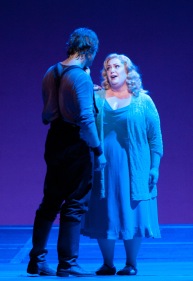
Merola/Adler veteran Heidi Melton got a chance to shine at Deutsche Oper last week, and she made the most of it. As reported by a Berlin blog (boldly mixing German and English where no man went before), she replaced the originally scheduled Sieglinde in a production of Die Walküre, conducted by Donald Runnicles, former San Francisco Opera music director, now filling the same position there.
For someone relatively new in the role, what [Melton] has offered is more than praiseworthy. First, her jugendlich dramatisch soprano is extremely pleasant on the ear, well-focused and rich in its lower reaches. Second, she is an elegant, musicianly singer. Third, she has a radiant stage presence and proved to be a particularly alert and engaged actress.The report finds fault with Runnicles, whose many San Francisco Wagner performances have been of the highest order:Moreover, she could find the right note of vulnerability in her Sieglinde — and her expression of gratitude to Brünnhilde in Act 3 was powerfully, richly and most sensitively sung.
I still haven’t seen a really satisfying Walküre from Donald Runnicles in the Deutsche Oper — and this evening was no exception. Die Walküre often takes off from Act 2 on ... it is the more "romantic" act and one wants softer tonal quality, a more flexible tempo, a bit more Innigkeit, but at the same time, this is still a big echt Wagnerian orchestra. If the conductor and his orchestra cannot achieve this lightness without loosing focus (both in the sense of clean articulation and of a distinctive tonal quality), then the sound picture becomes often matted and shapeless — as this evening. If Act 2 worked better, it is because the dark, weighty sound are more appropriate for the prevailing gloom. But still, at some moments, one could feel how long Act 2 is. [Act 3] started most commendably — absolute structural clarity until the Valkyries started to sing. Not only the conductor could not find the right balance between singers and orchestra, but also the singers were not truly well adjusted between themselves. After that, the performance settled in a comfortable, often convincingly rich-toned but hardly unforgettable frame.

